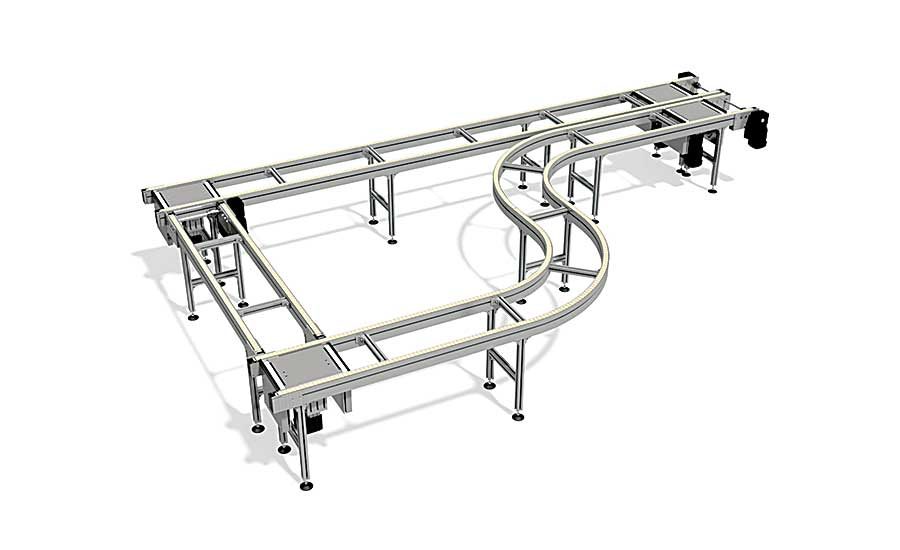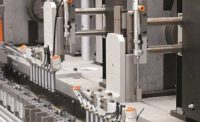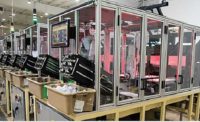Manufacturing companies contributed $2.17 trillion to the U.S. economy according to the most recent annual data. Manufacturers, of which 98.6 percent qualify as small businesses, have become more agile, more productive and leaner in recent years. These advances have reduced both time to market and labor costs. Factory automation has been a key driver behind many of these improvements, and pallet conveyor systems continue to be a crucial component for virtually every manufacturer seeking to improve efficiencies, agility and profits.
A pallet conveyor system transfers materials and work in process from one point of the production line to another. Those items may be heavy, bulky and hard to handle manually, or small, lightweight and delicate. Pallets typically range from around 10 by 10 inches to nearly 48 by 48 inches. They are capable of carrying loads weighing less than a pound or up to several hundred pounds. Because conveyor systems are designed as modular components (or modules) that are easily joined together, moving items over long distances, changing elevations and around corners can be easily accomplished.
In practice, the pallet carries parts to be assembled. The pallet may be freed from the conveyor drive mechanism when it reaches the operator, then returned to the conveyor once the assembly is complete; or the operation can be completed while the pallet is still on the main line. Steps in the assembly process can include drilling, tapping, welding, soldering, machining, screwdriving and pressing.
The Benefits of Pallet Conveyors
Pallet conveyor systems deliver several important benefits. They can continuously move materials from point to point, handling every item in the same fashion with no variance. Production inefficiencies and wasteful delays are eliminated by streamlining and standardizing the movement of material. A consistent material handling routine ultimately reduces work in process and allows greater throughput.
In addition, pallet conveyors eliminate bottlenecks and operations that require labor but do not add value. For instance, a pallet conveyor can rotate its pallet and the piece it carries to the desired orientation so the next step in the production process can be applied immediately. Properly orienting the item saves the operator at the next station the wasteful step of rotating it before work can begin. This results in greater throughput and lower costs.
Types of Conveyor Systems
The two main types of conveyor systems are synchronous and nonsynchronous (or asynchronous). Synchronous conveyors run at a timed speed specified by the operator and do not allow for automated start, stop or other positioning functions. This means if one pallet stops, all the pallets must stop. There is a fixed spacing between the pallets and this never deviates.
Nonsynchronous conveyors accommodate different process speeds and pathways according to the job at hand. Pallets transport their payloads on the conveyor asynchronously to the next station, and can buffer prior to entering and after exiting a workstation. These nonsynchronous systems are designed as families of modular components. This approach offers great flexibility in deploying conveyor systems to meet any particular requirement.
The modular approach to designing pallet conveyor systems lets manufacturers adapt to changing demands and production requirements. Conveyors can be reconfigured to accommodate new processes. They can be modified to handle changing work flows by adding new modular components to the system. They can also be programmed via control panels to change the flow over an existing system.
Pallet Conveyor Modules
The flexibility of nonsynchronous conveyors derives from the many modular components that give the overall system its capabilities. The most common modules, such as the following, can be combined to increase the overall productivity and flexibility of the line.
Pallets are an essential component in modular pallet-handling systems. Pallets come in a variety of different sizes, styles and materials—all of which can be tailored to the needs of each specific application. Pallets can be outfitted with fixtures and devices to hold and engage the product as it travels down the assembly line.
Main line conveyors are the primary conveyors in a pallet-handling system. These units are typically dual-strand conveyors. They feature either accumulating roller chain, flat top chain or timing belts as the conveying medium.
Traverse conveyors are used to move pallets short distances, typically between main line runs. Traverse conveyors can also be designed as walk-through gates allowing operators to access the inside of the production line. Spur conveyors are used to move pallets in and out the main line runs.
Lift and transfer units are used to move pallets between adjacent lines at a right angle. The lift and transfer module is positioned between the strands of the mainline conveyor. It features a small conveyor mounted to a device capable of vertical movement (typically a pneumatic cylinder).
Pallet stops are used to stop, separate or queue pallets at or before a particular location or assembly station. They are the primary source for controlling traffic flow on a pallet-handling conveyor system. They come in a variety of styles, including ones with adjustable dampening and can be positioned to engage with the bottom of the pallet, either on the edge or in the center. They work in conjunction with the various modules such as lift and transfer, lift and rotate and positioning units.
Positioning units are designed to accurately and precisely locate the pallet. This is often accomplished via a lift and locate module. This module locates the pallet, typically in two places, then lifts it off the conveyor to maintain location and accuracy during the assembly or testing process, while the conveyor continues to run.
Lift and rotate devices lift the pallet off the main line, traverse or spur conveyor and rotates it either 90 degrees or 180 degrees and then lowers the pallet back onto the conveyor. These modules are used to change the orientation of the pallet.
Vertical transfer units (VTUs) are used to move pallets between various mainline elevations. They are commonly used in over and under pallet-handling systems, which are often used when space is at a premium. VTUs feature a small conveyor to move the pallet in and out of the module, and guide the pallet’s vertical movement between levels.
Following the installation of a nonsynchronous conveyors system, manufacturers can expect the following outcomes.
Increased Productivity through Design
The modular design of a pallet-handling conveyor systems allows for the production line to grow as the needs of the company grow. Work cells and individual tasks can be joined together to increase productivity, and the line can be expanded as manual processes are replaced by
automated ones.
Modular pallet-handling systems mean the assembly line can be reconfigured based on changing requirements. If the assembly line needs to be moved to a new location, the conveyors and its modules can be packed up, moved and set up in the new location. Conveyors can be lengthened or
shortened, just as modules can be added or removed from the line.
Having control over the footprint of the assembly lines means manufacturers can tailor the conveyor system to work within the existing factory layout. The modular design and construction of today’s pallet-handling systems allows for a variety of different configurations. These systems can be designed in compact footprints to maximize floor space. Furthermore the use of a pallet allows the same system to run multiple products with little change-over, providing for significant efficiencies and cost savings.
By reducing the amount of work-in-process (or WIP) on the production floor, it is possible to lower the amount of product in stock on the floor and free up valuable production space. This reduces the capital employed on the floor. Pallet-handling conveyor systems, by design, continuously move product down the line from workstation to workstation, which is essential in reducing WIP.
Flexibility Based on Product Demand
The ability to adapt to changing product demands is necessary in today’s agile manufacturing facility. Pallet conveyors can help improve agility. For instance, line speed and product flow can be altered based on product demand. Such adjustments are achieved through the use of automation controls and conveyor line spurs, storage devices and reconfiguring the layout.
A single product being transported over the conveyor may need multiple processes such as screwdriving, welding, cleaning and testing so that it can be fully assembled. Another product usually requires a different mix of steps. Such diversity in products, coupled with the need to adapt to changing technology, requires flexibility in the design of the conveyor system.
Parts that have been rejected at the various testing stations can be moved to a reject line. On this line they can be reworked and reintroduced to the test station for secondary testing. All of this can be achieved while allowing products that have passed inspection to continue along the normal flow. This parallel product flow allows for increased productivity and output.
Improved Ergonomics
Working in an ergonomic environment increases worker productivity. What’s more, some states and countries have made the provision of ergonomic working conditions a legal mandate. Pallet-handling conveyor systems address ergonomics is several ways. Noise volume is an important ergonomic factor, and pallet conveyors are quieter than old style roller conveyor systems. Various modules, such as positioning and rotating devices, properly orientate the part in front of the worker, thus reducing repetitive motions which can lead to worker fatigue and injury. Additionally, spur conveyors can take the pallets off the mainline and position them directly in front of the worker in a workstation.
Automation Controls
The use of automation controls allows for various processes (both manual and automatic) and testing to be carried out on the same pallet-handling line. Pallets can be outfitted with a variety of read-write devices that communicate with the main control panel. Safety switches and devices can also be incorporated into the automation controls, creating a safer and more secure work environment.
Lean manufacturing, advancements in almost every aspect of technology, and the pressures of a worldwide economic downturn since 2008 have led forward-thinking companies to embrace those technologies that deliver the greatest return on their investments. Pallet conveyor systems have played a major role in giving manufacturers the flexibility they need to compete. These systems improve manufacturing productivity and product quality while allowing for maximum assembly flexibility. Pallet conveyor systems have become a must-have resource for manufacturing firms both large and small that want to compete successfully in the worldwide marketplace.






